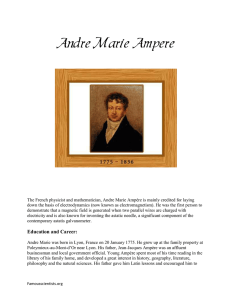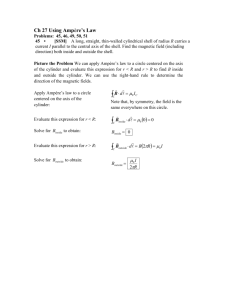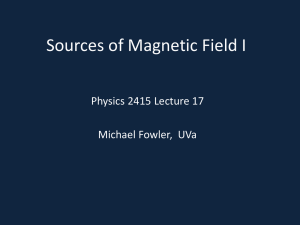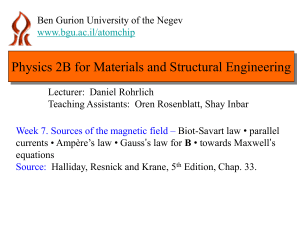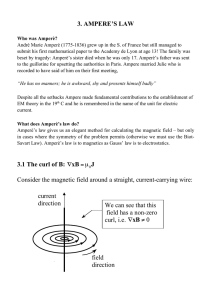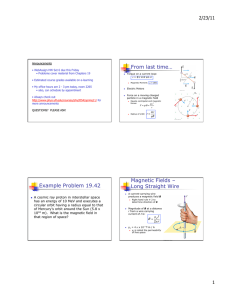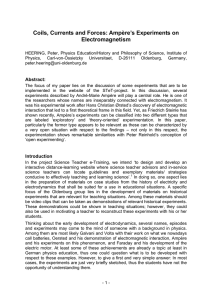Lecture 16 Ampère`s Law
advertisement
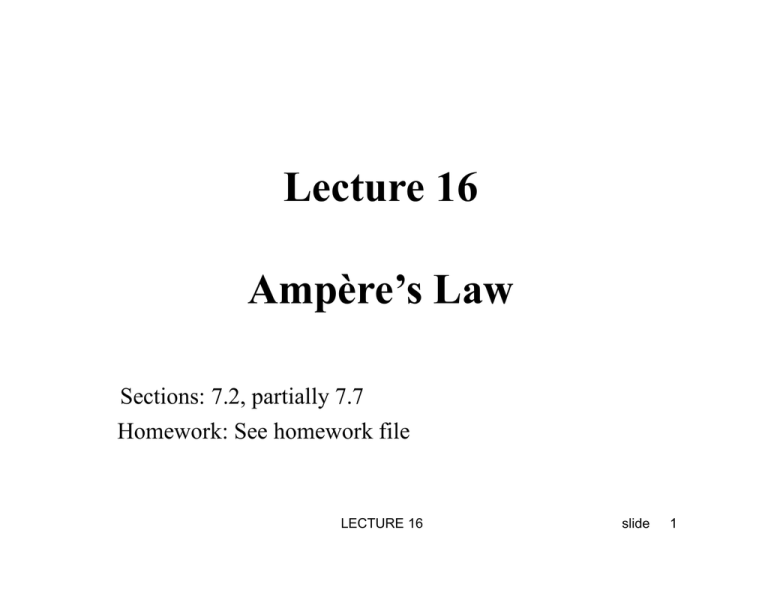
Lecture 16 Ampère’s Law Sections: 7.2, partially 7.7 Homework: See homework file LECTURE 16 slide 1 Ampère’s Law in Integral Form – 1 • the field of a straight wire with current (Lecture 15) I B a ,T 2 H a I 2 az I , A/m • for this cylindrically symmetric problem with circular field lines the result suggests the relation a H dL I encl C • Ampère’s law can be derived from the Biot-Savart law (section 7.7 in textbook, Hayt/Buck 8th ed.) LECTURE 16 slide 2 Ampère’s Law in Integral Form – 2 H dL I encl J ds C[ S ] S • contour C can be any – does not need to be a field line • I is total current flowing through area S bounded by C • positive I relates to the direction of C by the right-hand rule LECTURE 16 slide 3 Ampère’s Law in Integral Form – 3 examples on the sign of current contributions I2 I2 I1 I1 C H dL I1 I 2 C H dL I1 I 2 C I1 C I2 H dL I1 I 2 C C LECTURE 16 slide 4 Applications of Ampère’s Law • problems where the magnetic field is circularly symmetric • contours exist, along which the magnetic field is constant or zero – Ampère’s contours • concept is similar to Gauss law in electrostatics LECTURE 16 slide 5 Applications of Ampère’s Law: Straight Thin Wire Example 1: Find the magnetic field of an infinitesimally thin straight wire with current. az H dL Iencl C 2 ( d ) I encl H a a 0 H 2 I H I dL I 2 , A/m C[ S ] a H same result obtained via Biot-Savart law in Lecture 15 LECTURE 16 slide 6 Applications of Ampère’s Law: Straight Thick Wire – 1 Example 2: A straight conductor of circular cross-section and radius a carries current I. Find the magnetic field inside and outside the conductor. The conductor has no magnetic properties. (a) outside – case the same as in Example 1 P a total enclosed current is I H ( P ) I 2 P , A/m J (b) inside P a assume uniform current distribution I J 2 a z , A/m 2 a LECTURE 16 P P P P a slide 7 Applications of Ampère’s Law: Straight Thick Wire – 2 2 I P 2 P H 2 P J P I 2 H ( P ) , A/m 2 a 2 a I encl H I 2 a 0 LECTURE 16 1/ P P a slide P 8 Applications of Ampère’s Law: Straight Thick Wire – 3 LECTURE 16 slide 9 Applications of Ampère’s Law: Coaxial Cable – 1 Example 3: Find the magnetic field everywhere in the cross-section of a coaxial cable. (a) inside wire, ρP ≤ a – same as in Example 2-b I c b I P H , A/m 2 2 a a H (b) between wire and shield, a ≤ ρP ≤ b – same as in Example 2-a H I 2 P , A/m (c) inside shield, b ≤ ρP ≤ c 2 P H I J ( 2 P b2 ) I 2 b2 ) I ( P (c 2 b 2 ) LECTURE 16 slide 10 Applications of Ampère’s Law: Coaxial Cable – 2 (c) inside shield, cont. I (c 2 P2 ) H 2 2 2 P (c b ) LECTURE 16 (d) outside cable, ρP > c H ? slide 11 Applications of Ampère’s Law: Toroid Example 4: Find the magnetic field inside a toroid of N turns carrying current I. H dL I encl I C C H H 2 N I 2 N I H , 1 2 2 I 1 a What is the field outside the toroid? LECTURE 16 slide 12 Applications of Ampère’s Law: Surface Current Sheet – 1 Example 5: Find the magnetic field due to an infinite sheet of uniform current flowing in the y-direction. H field does not vary with x and y since the source does not vary with x and y LECTURE 16 slide 13 Applications of Ampère’s Law: Surface Current Sheet – 2 Hy = 0 since current is along y (field is always ┴ to current) Hz = 0 due to cancellation of contributions from two symmetrical current elements along x z y #j Hk P H H j H k H xa x Hj x #k resultant field has only x-component and does not vary with x and y LECTURE 16 slide 14 Applications of Ampère’s Law: Surface Current Sheet – 3 apply Ampère’s law along xz plane contour 1-1'-2'-2-1 H dL I encl C 1 field does not vary with x 2 2 1 H x1dx ( H z )dz ( H x 2 )dx H z dz K y L 1 1 2 2 0 0 zero contribution from segments 1'-2' and 2-1 (Hz = 0) H x1L H x 2 L K y L H x1 H x 2 K y H1 as follows from Biot-Savart’s law, field is anti-symmetrical wrt the current sheet z y H x 2 H x1 H x1 K y / 2, H x 2 K y / 2 LECTURE 16 x IdLa y H2 slide 15 Applications of Ampère’s Law: Surface Current Sheet – 4 Ampère’s law can be applied to another xz plane contour stretched in the z-direction, see 3-3'-2'-2-3 3 2 3 H x3dx 2 ( H x 2 )dx K y L H x3 H x 2 K y H x 3 H x1 K y / 2 field does not depend on distance from the infinite current sheet result analogous to D-field of an infinite charged sheet P1 K an , A/m H 2 D s 2 K a n , C/m 2 LECTURE 16 H1 a n1 an 2 H 2 P2 slide 16 Surface current sheet of current density K = 4az A/m lies in the plane defined by y = 4. Find the magnetic field at the origin (0,0,0). 4 H ZAx is X-Axis LECTURE 16 slide 17 Applications of Ampère’s Law: Solenoid – 1 z field is constant in z and ϕ because the source is constant in z and ϕ H 0 because current is along Hρ = 0 because the ρ contributions of two symmetrical turns along z cancel Hj P H H j Hk H za z Hk a a #j K #k a z solenoid axis field has only a z-component and it is constant in z and ϕ LECTURE 16 NI Ka d slide 18 Applications of Ampère’s Law: Solenoid – 2 L H d L I encl 3 3 11 221 2 c d 2 NI H z1 L H z 2 L L az d 1 1 NI H z1 H z 2 b a d NI repeat along 11'3'31: H z1 H z 3 H z3 H z2 d outside the solenoid field is constant and zero (see contour a-b-c-d) H z ,ab H z ,cd 0 antisymmetry 2H z ,ab 0 H H z a z 0, a H z3 H z2 0 inside solenoid NI K K a , A/m H z1 d LECTURE 16 slide 19 You have learned: that the “work” integral of H along a closed path is not zero but is equal to the enclosed current (Ampère’s law) how to apply Ampère’s law to symmetric problems that the field of a current sheet is constant in space, it is tangential to the sheet but is orthogonal to the surface current (right-hand rule applies) what the field is in a toroid and in a solenoid (equal to the surface current density of the toroid/solenoid) what the field is inside wires with current (growing linearly inside the wire, decaying as 1/ρ outside) LECTURE 16 slide 20

